How has technology changed, and the way it is used?
Not long ago, plasma cutting was the domain of seasoned metal fabrication veterans. They knew how to tweak gas settings and adjust torch height to get the best cut on a plasma cutting table.
Today, many of the highly trained technicians have left the shop floor.
What is left is the plasma cutting system, which in many cases, still provides a quality cut but without the expertise needed to guide the machine.
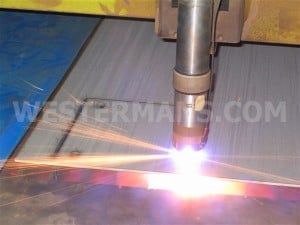
Technological advances have helped to automate programming for plasma cutting systems, and highly precise plasma cutting is now a reality.
How it Was.
Plasma cutting was invented in the mid-1950s.
The patent holder learned that sending a high-velocity jet of superheated gas through a constricted opening, ionised gas or plasma, is created. This plasma can melt metal.
The predominant method of thermal cutting at that time was gas cutting. An operator was required to control the torch head by hand, following a template. Or the torch head could be mounted to a gantry-style trace-eye machine, or a linear tracking rail.
Technology Developing.
By the mid-1960s, gantry profile cutting machines started becoming popular.
The marriage of oxy-acetylene to the NC gantry machines revolutionised the flame cutting process.
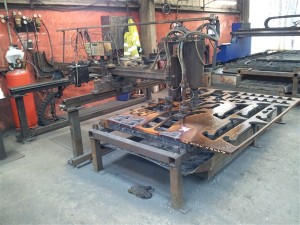
Plasma torches also were available on the gantry machines.
Manufacturers and fabricators didn’t generally accept plasma cutting until the mid-1970s.
The reason for the delay in the popularity of plasma cutting can be attributed to:
•System costs, especially the price of the gases required.
•Technology’s inability to match the thickness levels that oxy-acetylene could cut.
•Lack of public knowledge about plasma cutting capabilities.
•Lack of programming expertise.
User-friendly controls on the machine or on a nearby desktop, make setup on today’s plasma cutting machines quick and simple.
Popularity Developing.
By the 1980s, plasma cutting was growing in popularity, as more low-amperage systems began to be manufactured. Thinner metals now could be cut with plasma.
Electronic torch height control also was introduced. Electronically controlling the torch-to-workpiece distance allows the torch head to pierce the material at a greater distance. Minimising consumable wear and contributing to a more precise cut.
The PC also gained in popularity during this period.
Equipment programmers used the PC to generate ASCII text files that were used to direct the machine controller. Many machines continue to use this technology today.
Software Improvements.
CAD programs that could generate machine code became available in the late 1980s.
The CAD programmes, combined with the PC, provide a simple solution to programming the machine. The knowledge of G-code programming was no longer the only source to program the machine control. CNCs that allowed programming at the machine also became popular.
The 1980s were a time that encouraged some pioneering fabricators to run machine tools directly from the PC. Many who operated their machines in this way found the user interface to be much more user-friendly, when compared to rudimentary commercial control software offerings.
High-precision plasma cutting became available in the 1990s. Many cutting applications required the edge quality a laser machine could produce; no dross and smooth edges, but not the precise accuracy. These high-precision plasma cutting machines became an affordable option for these types of applications.
Now We Are Here
Today, fabricators benefit from the combination of the innovations that emerged in the previous decades. The refinement of plasma technology, the advancement of torch height controls, and the evolution of computer control technology, have resulted in a popular contour cutting solution.
Machine motion has improved because of advancements made in linear guiding, servomotors, and gearing. These include:
- Linear guiding technology now features higher load capacities, allowing for a stronger guide system to be mounted in a smaller place.
- AC servomotors are tuned digitally. The result is smoother motion and higher speeds.
- Antibacklash gear heads provide a more precise rotary-to-linear motion to achieve higher accuracy and torque.
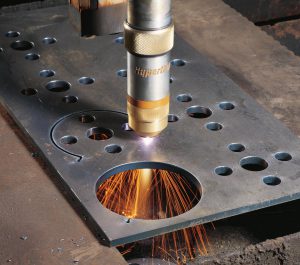
Automatic nesting software, common with many new plasma cutting machines, has made it easier to maximize material usage.
Current Technology.
Plasma cutting systems that feature these technologies have machine motion positioning accuracy of 0.004 inch. Systems of the past without sinusoidal AC servomotors, anti-backlash gear heads, and precision linear guides, normally would achieve only 0.015-in. positioning accuracy.
The tighter tolerance related to positioning accuracy minimises corner overshoot and maintains straighter lines during diagonal moves. This higher accuracy in machine motion directly corresponds to higher part accuracy.
The improvements to contouring technology, torch height control, and high-precision torch systems, enabled plasma machines to produce parts similar to laser-cut parts. All be it with slightly less accuracy. For example, 10-gauge cold-rolled steel sheet that’s laser-cut, normally yields a part with an accuracy of ±0.005 in. While the same material cut with a high-precision plasma torch yields a part within ±0.012 in.
Having said that, plasma cutting systems can cut thicker materials faster than lasers, and produce quality parts at the same time.
Plasma technology has remained a viable cutting technology alternative, even in today’s world of precision fabricating.
Fact
11 years ago, Hypertherm produced the Powermax 600 plasma. It has now sold 50,000 systems, making it the best-selling system for this manufacturer.
Learn more about the range of new plasma cutters available
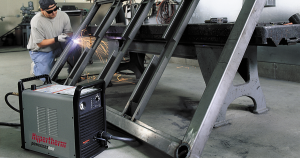
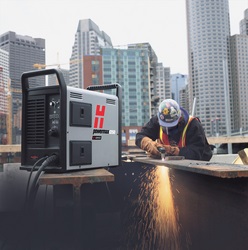

comments
Pingback: Welding Terms & their definitions – www.materialwelding.com
Pingback: Welding Terms & their definitions
I didn’t know plasma cutting has been existing for a long time. Technology really is amazing
Glad you enjoyed it Kevin. Hope you are busy plasma cutting – why not shares with us some of your projects?
It’s amazing that plasma cutting was invented in the mid-1950s. I had assumed that it was invented later than that. Thanks for all the great information on plasma cutting!